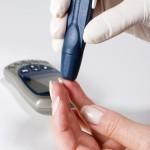
Diabetes is a disease in which the body cannot metabolize and regulate sugar (glucose) properly in the blood. There are 3 forms of diabetes: Type 1, Type 2 and Gestational.
- Type 1 Diabetes is typically diagnosed in children and young adults and is often referred to as Juvenile Diabetes. It is estimated that this form of diabetes affects 5% of the population. With Type 1 Diabetes, the body cannot produce insulin, which is a hormone required to convert sugar or starch into energy. With insulin medication therapy and a healthy lifestyle, Type 1 diabetes can easily be controlled.
- Type 2 Diabetes is the most common form of diabetes. Unlike those with Type 1 Diabetes, the bodies of those with Type 2 Diabetes make insulin. However, either their pancreas fails to make enough or their body cannot utilize it properly to stabilize blood sugar levels.
- Gestational Diabetes is when an expecting mother has high blood sugar levels. It occurs with approximately 4% of pregnant women. It is often screened for and diagnosed during the first trimester of pregnancy. Typically after delivery, the condition dissipates.
Scheduling a yearly physical examination is beneficial for many reasons, including obtaining a blood workup to screen for out of range glucose levels that may lead to diabetes. Some warning signs of diabetes include: increased thirst or hunger, dry mouth, frequent urination, unexplained weight loss, fatigue, blurred vision, and headaches. If diabetes is not diagnosed and treated within the early stages, the body can experience major harm including nerve and blood vessel damage in the eyes, kidneys, and heart. It can also cause hardening of the arteries in the heart that may lead to stroke or heart attack and dehydration due to the buildup of sugar in the blood stream. Lastly, unregulated diabetes can lead to diabetic coma.
Becoming aware, following a few simple steps, and developing a healthy lifestyle may help prevent the onset of diabetes. Controlling your weight, eating healthy well-balanced meals, limiting sugary foods and drinks, increasing water intake, staying physically active, avoiding smoking and limiting alcohol consumption are simple ways to stay healthy and decreases the likelihood of a diabetes diagnosis.
Medical Assistants work with physicians who diagnose and treat patients for aliments including diabetes. Medical Assistants and Phlebotomists are trained to perform blood draws and finger pricks to screen for diseases, such as diabetes. If the medical field interests you, Arizona College offers Medical Assisting with Phlebotomy training programs that could help you start your new medical career. Contact us for a tour of our modern facilities and laboratories and begin the journey to your new healthcare career today!
Information in this blog post is accurate as of November 6, 2014.
